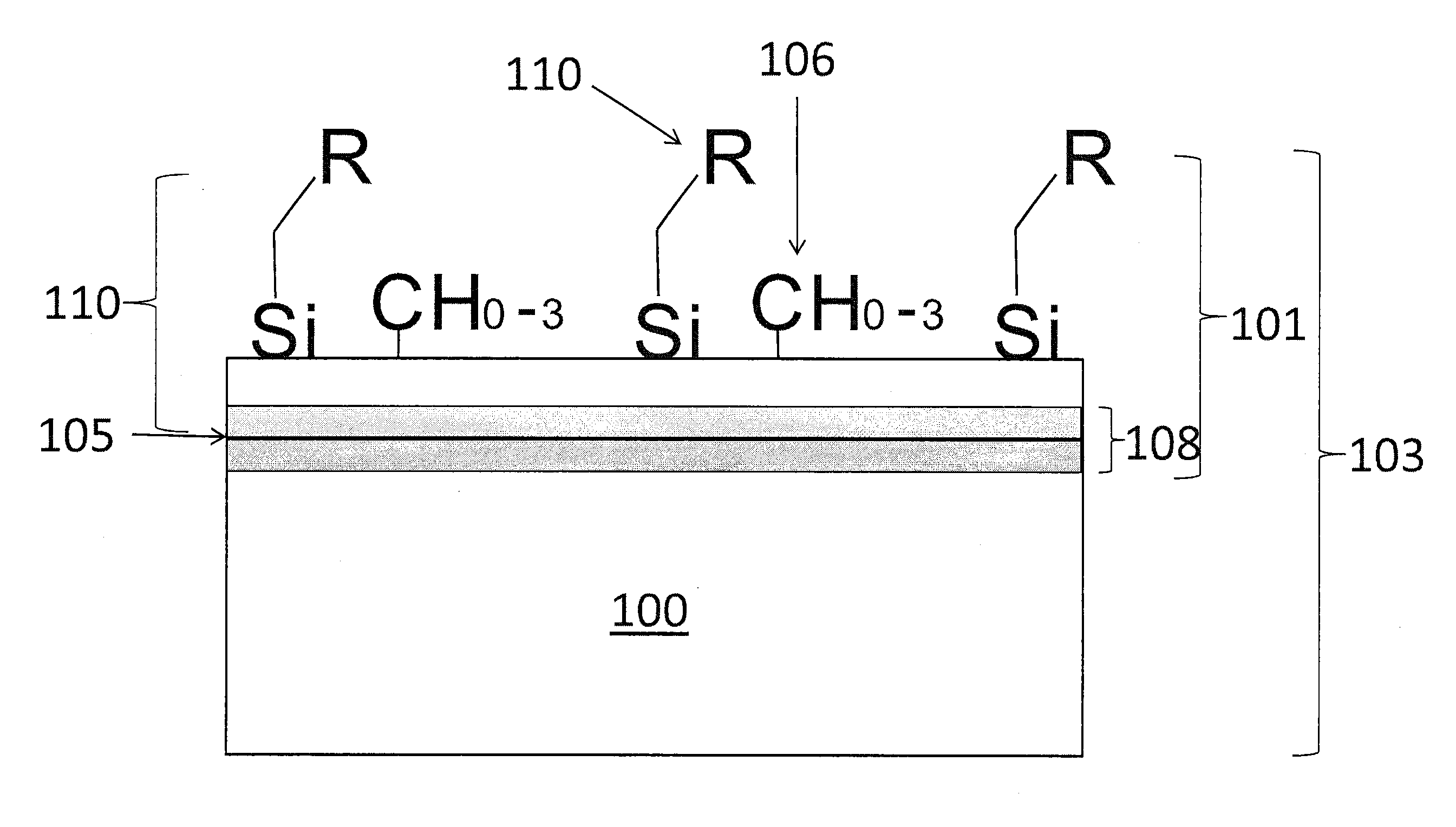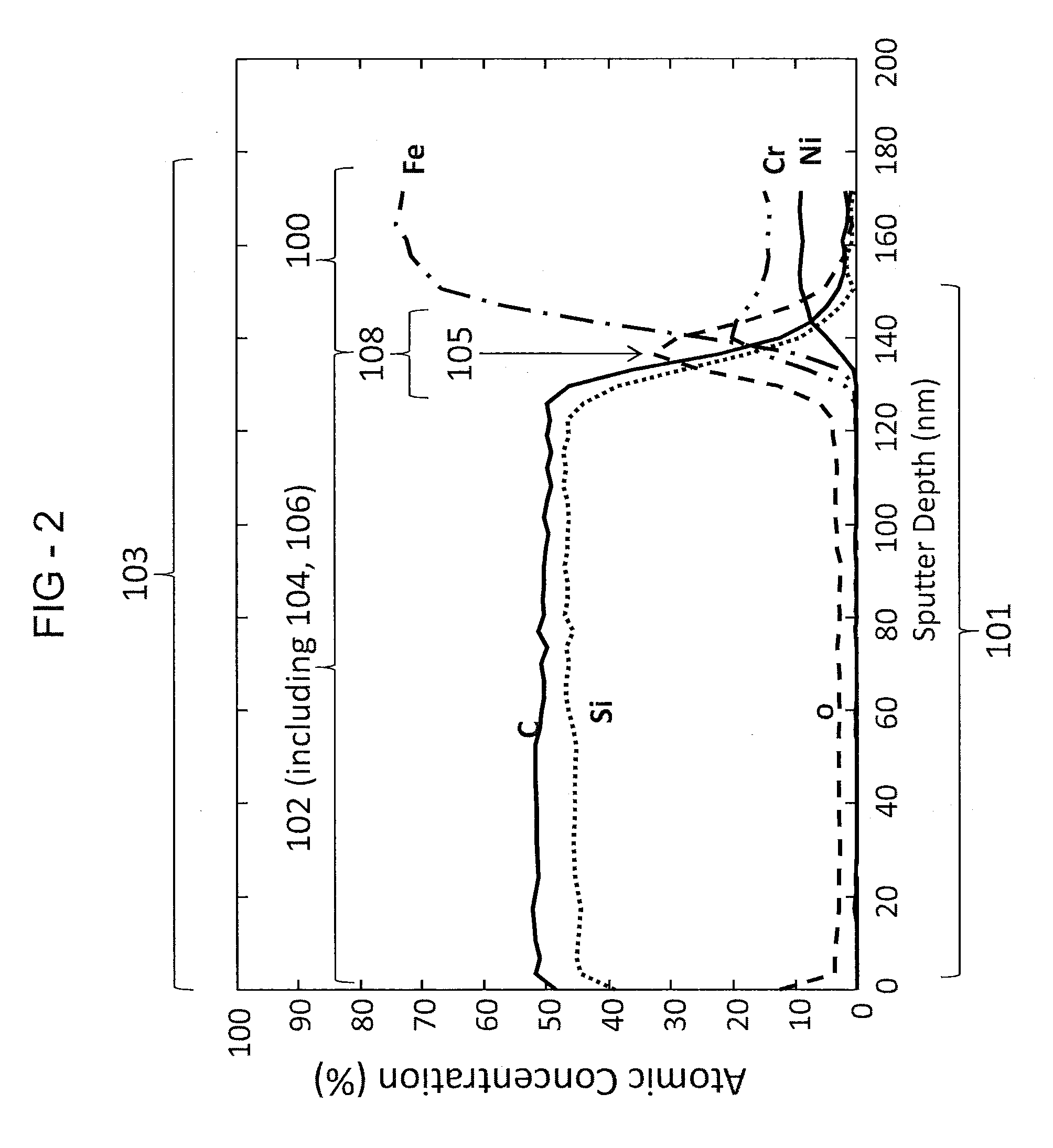Chemical vapor deposition coating, article, and method
a technology of chemical vapor deposition and coating, applied in the chemical field, can solve the problems of inability to meet certain performance requirements, surface degradation in certain environments, and combinations, and achieve the effects of improving use, improving wear resistance and hardness, and reducing or eliminating residual catalyst activity
- Summary
- Abstract
- Description
- Claims
- Application Information
AI Technical Summary
Benefits of technology
Problems solved by technology
Method used
Image
Examples
example 1
[0061]The first example included introducing dimethylsilane to the substrate 100 for 2 hours at 8 p.s.i.a. gas at 450° C. to form the layer 102. In the first example, the layer 102 was almost undetectable (i.e., very difficult to visually discern) on a mirror-polished 316 stainless steel coupon (slightly yellowed). Measurements showed water contact angle data prior to the deposition treatment at around 60°. After the deposition treatment with dimethylsilane, the contact angle increased to around 102°. Although the layer 102 was not visible, the data indicated an extremely thin deposition with a significant density of carbosilyl material on the layer 102 of the surface 105. The thickness of the layer 102 was estimated to be at about 100 Angstroms as available spectroscopic techniques were not sensitive enough to detect the coating.
example 2
[0062]The second example included introducing dimethylsilane to the substrate 100 for 15 hours at 8 p.s.i.a. gas at 450° C. to form the layer 102. In the second example, the layer 102 had a visible luminescent rainbow array of colors. Measurements showed average deionized water contact angle data around 100°, for mirror-finished 316 stainless steel surfaces and polished silicon wafer surfaces. FT-IR indicated presence of C—H based upon a reading at 2950 cm−1, the presence of Si—C based upon a reading at 792 cm−1, and the presence of Si—H moieties based upon a reading at 2102 cm−1. The thickness of the layer 102 was determined by spectrometer to be about 800 Angstroms. Further measurements utilizing Auger Electron Spectroscopy were also performed. The measurements showed increased concentrations of Si and C atoms on the layer 102. The measurement further showed the concentration of Si and C atoms decreasing upon reaching the diffusion region 108 illustrated by the increase in concent...
example 3
[0063]The third example included introducing dimethylsilane to the substrate 100 for 15 hours at 8 p.s.i.a. gas at 450° C. to form the layer 102 and subsequently oxidizing the layer 102 of the substrate 100 with water in an inert gas for 2 hours at about 100 to 200 p.s.i.a. gas at 450° C. to form the oxidized layer 802. FT-IR data failed to reveal the significant presence of any functional moieties (Si—OH or Si—H) for surface modification chemistry. The resultant carboxysilane material revealed an improvement in hardness and wear resistance over the native carbosilane. The oxidized layer 802 had a contact angle on a Si wafer of 86.6°, and an increased presence of Si—O—Si groups.
PUM
| Property | Measurement | Unit |
|---|---|---|
| pressure | aaaaa | aaaaa |
| temperature | aaaaa | aaaaa |
| temperature | aaaaa | aaaaa |
Abstract
Description
Claims
Application Information
 Login to View More
Login to View More - R&D
- Intellectual Property
- Life Sciences
- Materials
- Tech Scout
- Unparalleled Data Quality
- Higher Quality Content
- 60% Fewer Hallucinations
Browse by: Latest US Patents, China's latest patents, Technical Efficacy Thesaurus, Application Domain, Technology Topic, Popular Technical Reports.
© 2025 PatSnap. All rights reserved.Legal|Privacy policy|Modern Slavery Act Transparency Statement|Sitemap|About US| Contact US: help@patsnap.com



